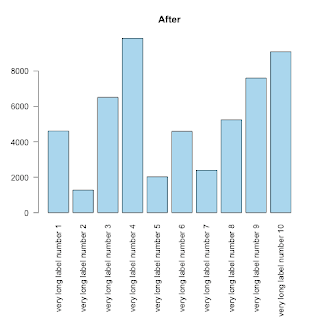(1) Use ~/.Rprofile for repeated environment initialization
(2) Ever have the problem of a large data frame only being displayed across 40% of your terminal window? Then, you can resize the R display to fit the size of your terminal window. Use the following "wideScreen" function:
# define wideScreen
wideScreen <- function() {
options(width=as.integer(Sys.getenv("COLUMNS")));
}
#
# Test wideScreen
#
a <- rnorm(100)
a
wideScreen()
# notice how the data fill the screen
a (3) Get familiar with colorspace. For example, if you need to color data points across a range, you can easily do:
##
## lut.R -- small function that returns a cool pallete of nColors
##
require(colorspace)
lut <- function(nColors=20) {
return(hex(HSV(seq(0, 360, length=nColors)[-nColors], 1, 1)));
}
# Now use lut.
plot( rnorm(100), col=lut(100)[1:100] )
# Now use just a range; use colors near purple; pretty
# much like gettins subsections of rainbow.colors()
plot( rnorm(30), col=lut(100)[71:100] ) (4) Given an N-dimensional data set, (m instances in N dimensions), find the K-nearest neighbors to a given row/instance/point:
##
## neighbors -- find and return the K closest neighbors to "home"
##
neighbors <- function( dat, home, k=10 ) {
theHood <- apply( dat, 1, function(x) sqrt(sum((x-home)**2)))
return(order(theHood)[1:k] )
}
# Use it. Create a random 10x10 matrix and find which rows
# in D are closest (Euclidean-wise) to row 1.
d <- matrix( rnorm(100), nrow=10, ncol=10)
neighbors(d, d[1,], k=3)(5) A _VERY_ useful tip is to show the users the vast difference in speed between using for, apply, sapply, mapply and tapply. A for loop is typically very slow, where the ?apply family is great. You can use the apply vs for-loop in the neighbors function above with a timer on a large set to show the difference.
(6) Another useful tip, also in neighbors is generating difference vectors and their lengths:
# the difference vector between two vectors is very easy,
c <- a -b
# now the vector length (how far apart in Euclidean space these two points are)
sqrt(sum(c**2))
